

#Jupyter notebooks code#
Move your code from your Notebook into a Python package.But wouldn’t it be great if you could have both the assistance of an IDE and the interactivity of a Notebook? TL DR

One solution for writing less terrible code in Notebooks, is to only use an IDE and write no code in Notebooks.
#Jupyter notebooks full#
Notebooks written by data scientist are notorious for being unreadable, unreproducible and full of bugs how can we get them to write better code? However, they don’t help you like an IDE with, for instance, code linting and refactoring. I love Notebooks for trying out new things, plotting, documenting my research, and as an educational tool. The Jupyter Variables tool window the detailed report about variable values of the executed cell.Jupyter Notebook (or Lab) is great for prototyping but not really suited for writing good code. It also provides controls to stop the running server ( ) and launch the stopped server ( ). The Server log tab of this window shows the current state of the Jupyter server and the link to the notebook in a browser. The Server Log tab of the Jupyter tool window appears when you have any of the Jupyter server launched. You can preview the notebook in a browser. Select this checkbox to allow executing JavaScript in your Jupyter notebook. Click the widget and select Configure Jupyter Server to setup another local or remote Jupyter server. The Jupyter Server widget that shows the currently used Jupyter server. You can select a cell type from this list and change the type for the selected cell. If there is no a cell below, DataSpell will create it.Ĭlick this icon if you want to interrupt any cell execution.Ĭlick this icon to restart the currently running kernel. If you've selected an entire cell, the contents are pasted to a new cell below the selected one.Įxecutes this cell and selects a cell below. Inserts the contents of the clipboard into the selected location. Moves the entire cell if it's selected.Ĭopies the selected item or items to the clipboard.

Moves the selected item or items from the current location to the clipboard. To enable them, open project Settings ( Ctrl+Alt+S), go to Languages & Frameworks | Jupyter, and select the Show cell toolbar checkbox.Īdds a code cell below the selected cell. To enable them, open project Settings ( Ctrl+Alt+S), go to Languages & Frameworks | Jupyter, and select the Show cell toolbar checkbox.Įach code cell has its configurable toolbar so that you can easily access the most popular commands and actions. The rest of the notebook specific actions are available in the Cell menu.Ĭode cell: a notebook cell that contains an executable codeĬell output: results of the code cell execution can be presented by a text output, table, or plot.Ĭell toolbar: a toolbar of the code cell with the most popular commands. Jupyter notebook toolbar: provides quick access to the most popular actions. Notebook editorĪ Jupyter notebook opened in the editor has its specific UI elements: Mind the following user interface features when working with Jupyter notebooks in DataSpell. If needed, configure or create a new virtual environment.Įxecute any of the code cells to launch the Jupyter server. To start working with Jupyter notebooks in DataSpell: Quick start with the Jupyter notebook in DataSpell Shortcuts for basic operations with Jupyter notebooks.Ībility to recognize. With Jupyter Notebook integration available in DataSpell, you can easily edit, execute, and debug notebook source code and examine execution outputs including stream data, images, and other media.Ībility to run cells and preview execution results.


 0 kommentar(er)
0 kommentar(er)
